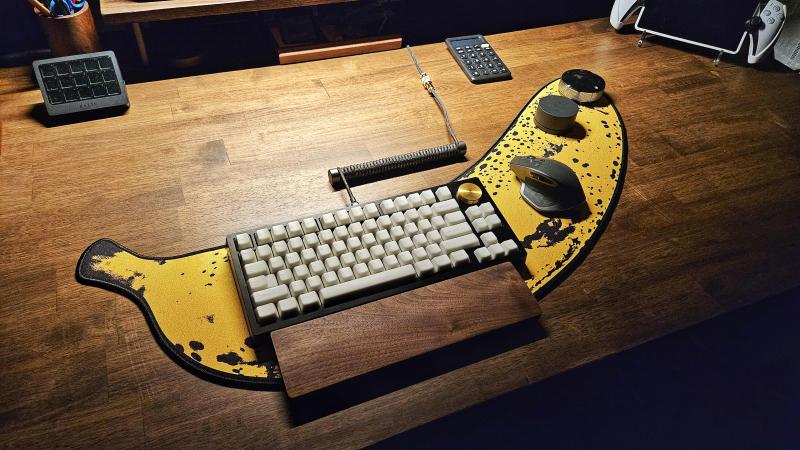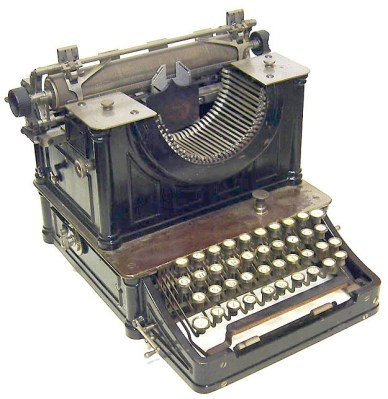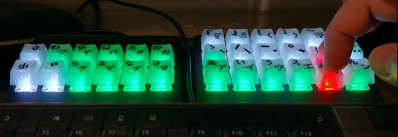
Okay, so we’re opening with more than just a keyboard, and that’s fine. In fact, it’s more than fine, it’s probably the cutest lil’ ZX Spectrum you’ll see today.
[SrBlonde]’s wonderful micro Spectrum project has only the essential inputs, which makes for an interesting-looking keyboard for sure. Inside you’ll find an Orange Pi Zero 2 board loaded with Batocera so [SrBlonde] can play all their favorite childhood games on the 5″ IPS display.
Something else that’s interesting is that the switches are a mix of blues and blacks — clickies and linears. I can’t figure out how they’re distributed based on the numbers in the components list, but I could see using clickies on the alphas and linears everywhere else (or vice versa). At any rate, it’s a great project, and you can grab the STL files from Thingiverse if you’re so inclined.
Zoom Keyboard Keeps It Simple

If you’ve ever used Zoom with any regularity, you may have longed for a keyboard much like this macro pad from [Olga Pavlova].
[Olga] is using this bad boy in an educational setting, so the hot keys are set up as follows: raise/lower hand, mute/un-mute audio, and show/hide the in-meeting chat panel. Simple plus useful equals elegant in my book. This keyboard is built on the ATtiny85, and you can find more details on GitHub including the code.
I’m quite drawn to the interesting design of this one, and I’m not quite sure what it reminds me of. Maybe an upside-down Steam logo. What do you think it looks like?
The Centerfold: Peel Slowly and See

Yep, this time we’re going with nature’s energy bar, the KBDFans banana desk mat. Although there’s no edible banana for scale, there is a nice Mammoth75 keyboard, and a really lovely wrist rest that totally blends in with the desk. Believe it or not, those creamy keycaps aren’t from a group buy or anything crazy, they’re just some milky white PBTs from the Bezos Barn.
Do you rock a sweet set of peripherals on a screamin’ desk pad? Send me a picture along with your handle and all the gory details, and you could be featured here!
Historical Clackers: the Yetman Transmitting Typewriter

The remarkably heavy Yetman Transmitting Typewriter of 1903 was a bit like a laptop of its time in that you could hook into the telegraph wires and send a message from anywhere. (Well, anywhere with telegraph wires.) And, at the same time, if you wanted, you could produce a hard copy of that message. Or, you could just use the thing as a normal typewriter.
And as far as normal typewriters go, the Yetman isn’t too outstanding aside from its transmitting capabilities. In order to transmit, you simply pressed the lever on the left side of the keyboard. To engage the typebars, you pressed a lever on the right.
You may have noticed the shelf above the keyboard with the strange knob. That is a Morse keyer for sending messages the traditional way. Many sources claimed that the Yetman could also receive transmissions, but that’s not the case.
There are many mysteries surrounding the Yetman, its inventor, and the company’s president, which you can read all about on the Oz Typewriter blog.
ICYMI: KanaChord, the Japanese Macro Pad

Want to input a little Japanese here and there on your computer? Normally you’d need to switch languages, but why not switch peripherals instead? That’s the idea behind [Mac Cody]’s KanaChord, which generates Unicode macros that render Japanese Kana characters by way of chords — multiple keys at once, like on a piano.
It’s simple, really, as long as you know your table of Kana — that’s how the Hirigana and Katakana elements of the Japanese language are collectively known. There’s also the Kanji, or Chinese characters that round it all out. This version of the KanaChord lacks the Kanji, but the KanaChord Plus Keyboard will have 6,000+ characters.
KanaChord uses color to differentiate between character types, to indicate Kana mode, and even provide error feedback whenever an invalid chord is pressed. Inside you’ll find a Raspberry Pi Pico and an Adafruit NeoKey 5×6 Ortho Snap-Apart keyboard PCB, which simplifies things considerably. Underneath those cool 3D-printed keycaps are thirty Cherry MX switches of unknown color, but which I choose to believe are blue.
Got a hot tip that has like, anything to do with keyboards? Help me out by sending in a link or two. Don’t want all the Hackaday scribes to see it? Feel free to email me directly.

Prestige
Interesting
Casper
Amazing